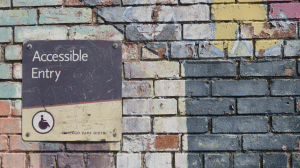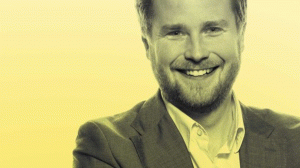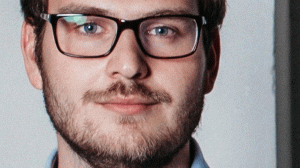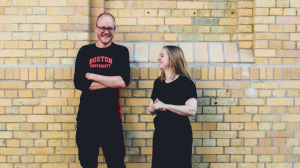|
This article is Part IV of a four article series. Check out the third article here. |
 |
++Part 4++
Kiron is a non-profit organization that provides refugees with digital learning opportunities for academic, professional and personal growth. In April 2018 our management decided to transform our organization and to form cross-functional teams for evidence-based and user-centered collaboration; they asked me to facilitate the process of setting it all up. In this article I want to share my lessons learned and to inspire other organisations to increase their impact.
No Time for Homework
When I get back from my first month of parental leave in January I find out that not everything goes as planned within the cross-functional teams or clusters. Setting topics, discussing them and prioritizing experiment docs works, but it’s hard to actually execute the experiments. We can identify a few reasons for this. Initially it’s very hard for the cluster leads to facilitate the newly formed groups. Many of the new people had not been part of the discussions and debates we had had in the stem cell for almost 4 months and need to go through a similar process. But the biggest problem is simply people’s time. Before the clusters no one had any trouble filling their days with work and now we ask them to spend 20% (more) on cross-functional work. They attend the meetings that take roughly two hours, but have almost no time to do any work in between meetings. Some experiments rely on help from functional teams, but they don’t have the resources to respond. The three cluster leads ask our management to help the functional teams to prioritze their work and to find ways to reduce everyone’s workload to create more room for innovation. Another suggestion is to enforce the rule in the constitution that people should assume to spend 20% of their time on cross-functional work by designating one full day per week to cluster work.
Version 0.4: February - July 2019
Innovation Thursday
In February 2019 we have our first ever Innovation Thursday at Kiron with all education, product, tech and cluster teams. Our innovation ecosystem grows from 22 to roughly 50 people. From now on they all spend one day a week on cross-functional innovation. All calendars are blocked and meeting rooms are reserved for this purpose.
The process we go through each innovation day is a more loose interpretation of the process (the rainbow chart) that the stem cell had co-created together with others: the three cluster leads collect and prioritize topics that are presented in the morning at the stand up with everyone present. Experiments are executed throughout the day within smaller groups that are formed based on skills needed. And there’s collective learning at the close-out when everyone shares their accomplishments of the day and the next steps they have planned.
Instead of using the backlog of experiment ideas we document each weeks topics and outcomes in slides. What we stop doing is the experiment docs and the prioritization through distributed decision-making. While that allows us to move more freely, it also makes it harder for us to track the impact of our activities (but more on that later).
In hindsight one can say that we overengineered the process and tools, but on the other hand I think it was needed for us in the stem cell to get on the same page, to dare to get started and for the other teams to trust our intentions. And especially in the beginning they served as water wings for us to learn to swim in the cold and stormy water that innovation undoubtedly is.
Now with 50 people working together in changing groups on each Innovation Thursday more and more people experience cross-functional and self-organized work and develop the necessary competences. The quality of relationships and trust between people and teams increases. The movement for what Laloux calls a green way of collaborating grows.
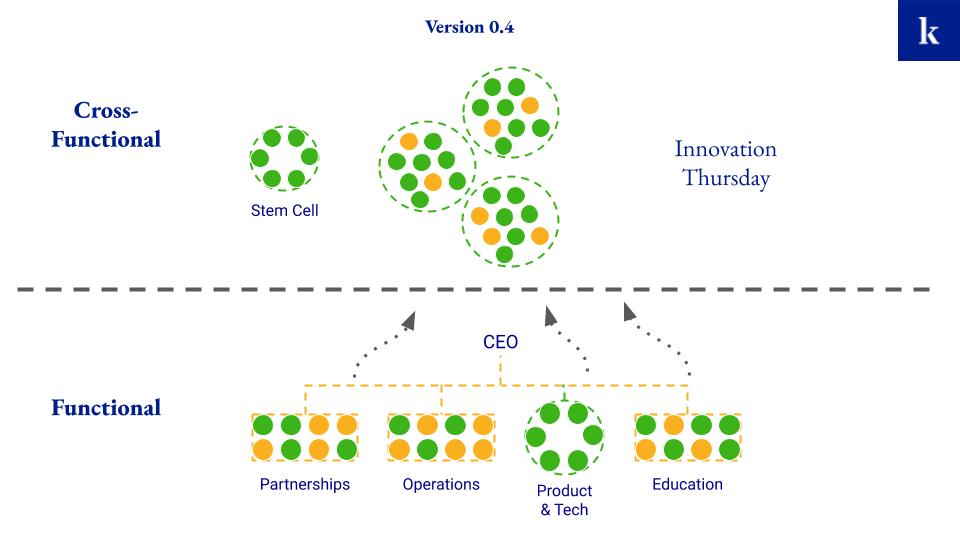
Collective Efforts
In parallel to the Innovation Thursdays a few other things help our innovation ecosystem to gain momentum. Our Learner Analytics team does a tremendous job with making relevant data available to people. We have more workshops to develop the competences needed for user-centered work - a design thinking workshop with Sharkbite and a customer discovery challenge with Podojo. Some functional teams go agile and the heads of the functional teams do a fantastic job in aligning and prioritizing their activities, which creates more room for cross-functional innovation. What really helps aswell both with developing competences for cross-functional and user-centered work and with improving the quality of relationsihps is the Open Anyday. It’s one day per month on which any Kironista can offer a workshop or invite an external speaker on any topic they find interesting. Anyone within the company can participate and join the workshops. Open Anydays were also a great inspiration for Innovation Thursdays.
Make Yourself Redundant
- “The shortest distance between two points is a straight line.” – Archimedes
All of these events also change my role as a facilitator. The cluster leads are doing tremendous work and don’t really need me to help them. I still talk to the leads and management and set our meetings agenda based on what I hear, but I feel like an operator working on one of these old telephone switchboards. And in this day and age that’s not needed anymore. People should have a direct line. Me being positioned between management and cluster leads also weakens the leads position. I realize that I’m holding up the evolution of the ecosystem myself and that I don’t have the decision making authority to make the changes needed to take the innovation ecosystem to the next level. There’s a saying in entrepreneurship to not work in the company, but on the company. So the explicit idea is to make yourself redundant to be able to focus your time and resources on the next challenge. I share my thoughts with our management and we agree to adapt my and everyone else’s role to the new reality. We make the following changes to the constitution:
- Cluster leads are allowed to spend up to 50% of their time on cross-functional work.
- Cluster leads meet together regularly with management representation.
- Cluster leads have regular one-on-one check-ins with a management member.
As a result our meeting agenda becomes more co-owned. The stem cell was integral in getting were we are, but with the new setup it’s less relevant and takes time and resources from people that are better spend elsewhere. We stop meeting. The stem cell had already created it’s offspring and those conversations now happen in other spaces.
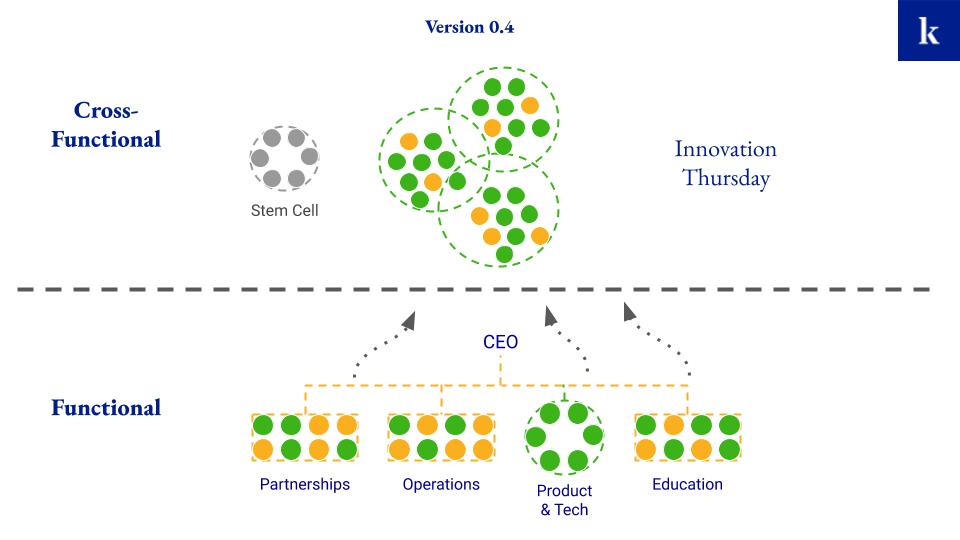
I successfully cut myself out of the equation and consciously create a space, a vacuum, hoping that it will be filled by others - and they do so beautifully! I still attend our meetings and give advise, but I’m less involved.
I’m not going to lie. The loss of importance is quite painful for me. Fewer people come to me with questions. Having studied entrepreneurship and corporate succession I know how owners of family businesses have a hard time handing over their company to the next generation and to „let go“. Now I get a bit of a taste of it myself. I take some comfort in the words from a lawyer whose book on open educational resources got translated and published in various languages without him knowing anything about it, because he had published it under a free licence. He said: “You lose control, but you gain influence.”
After 2 months of innovating the first results are presented at a party with a science fair format. All teams present their outcomes and you can experience and try out what people had learned and developed. This was awesome for everyone, but especially valuable for our Operations and Partnerships teams, because their participation in Innovation Thursday isn’t mandatory and they still operate within a more hierarchical structure.
Systemic Improvements
I had always tried to improve the overall conditions within the organization for user-centered work by starting and supporting initiatives that promised to have a big impact on the ecosystem as a whole. And some of the seeds I had planted earlier now start to grow. I studied entrepreneuship and corporate succession - and that’s what I do: I build things and hand them over to someone else. I try to take a birds eye view, identify an organizational need, develop a prototype, involve others and hope someone or “the system” (the organization) takes it over. If you operate within that way you lose control, but you gain influence and have more impact. If I’d have to see all the things that I start to completion I’d always be the bottleneck. Instead I try to foster collaboration between others, which is more sustainable - it doesn’t depend on me as a person. But what initiatives can have the biggest impact on the system?
Organizational Tensions
The biggest tensions within our organizational system (and that of most non-profits) boil down to two things:
- Serving Two Different Customers
Kiron, like many other non-profits, serves two different customers: donors and ultimate beneficiaries. In our case the donors are foundations or government agencies and the ultimate beneficiaries are refugees. This is called a multi-sided business model. A simple example from the for profit world: imagine a newspaper that’s free for the readers (ultimate beneficiaries/ users) and finances itself through advertisements (donors/ customers). In for-profit companies with only one customer the better your offer is, the higher your profits are. But our users, the refugees, don’t pay for our offer - the donors do. We always have to align both of our customers interests, which can add a lot of complexity.
- Waterfall vs. Agile Development
Waterfall development is “a breakdown of project activities into linear sequential phases, where each phase depends on the deliverables of the previous one”. But agile or lean work requires you to listen to your users, be flexible regarding your solution and co-create it together with the people you’re trying to help. The predominant funding mechanism for innovation is still to develop a project plan with sequential project deliverables. A study conducted by my old entrepreneurship professors has shown that there is no correlation between the quality of a (business) plan and the success of a startup. And there are many other people within the entrepreneurship community saying the same thing - e. g. Steve Blank, Eric Ries, Alex Osterwalder, and others. A (business) plan is fine when all variables about the business are known. But this is hardly ever the case with innovation, because the whole point of innovation is to find a solution that is not, yet, known. In the long term we need to develop better ways to fund for innovation and impact and we’re already doing the first steps with some of our partners (e. g. we had a co-creation workshop with GIZ before we wrote the project plan).
Long story short: to make our donors happy we need to execute the plan we agreed on, but to deliver the most possible value to our students we need to be agile and lean. In the end we need to do both. But how?
Acupuncture Points
Often smaller changes within the system can have a big impact - I like to call these small changes acupuncture points. The systemic tensions mentioned in the previous chapter can shed light on where to look and what to look for. The next step is to find out how these tensions manifest itself in practice - e. g. through the types of meetings people have, who is involved and who isn’t, the tools that people are using to collaborate, etc. While finding acupuncture points can be quite hard, inserting the needle is even harder, because you can’t do it alone and need other people to help you. Here are a few acupuncture points that I identified within the non-proft context:
Customer Interviews
- “There are no facts inside your building, so get the heck outside.” – Steve Blank
We have personal conversations with our donors on a regular basis when we negotiate and agree on a project and report on it’s progress. But talking to our ultimate beneficiaries or users (our students) is a lot harder. There are multiple ways to raise the volume of the users voice, though. We’ve always done a lot of quantitative and qualitative analyses, but for innovation personal conversations are key - survey responses and graphs are only part of the story and half of the truth. Real insights are generated in face-to-face conversations, when we meet the people where they are and can delve deeper into topics that come up spontaneously. But given that our students live almost anywhere in the world meeting them in person can be very hard. The challenges for a refugee in Germany differ wildly from those of a student in a refugee camp in Kenya. Sometimes we are lucky to be able to do a field mission, but that’s not always possible. So we’ve started to reach out to students to interview them in person through video chats. This is easier said than done, because many students don’t have a stable internet connection and may have trouble speaking english. But we did some capacity building and developed the know how, processes and tools to do these regular student interviews and they have become a very important part of our work.
KPI’s: AARRR
The KPI’s (key performance indicators) of an organization obviously have a big impact on how efforts are channeled within an organization. For a non-profit it’s important that KPI’s focus on the ultimate beneficiaries. The good thing: there’s no need to reinvent the wheel! There’s a great framework to start with called AARRR by Dave McClure. AARRR stands for:
- “A: Acquisition - where / what channels do users come from?
- A: Activation - what % have a "happy" initial experience?
- R: Retention - do they come back & re-visit over time?
- R: Referral - do they like it enough to tell their friends?
- R: Revenue - can you monetize any of this behavior?”
Based on this framework you can develop quantitative KPI’s. There are lot’s of examples - just do a search online. The most important KPI for digital products is usually retention and there are free resources out there that can help you measure and define it.
Definition of Done for Project Deliverables
We used to have regular (weekly or bi-weekly) project meetings to check if everyone is on track with their project deliverables. Depending on the size of the project we sometimes had more than 10 people in the room. And we have multiple big projects. This took a lot of people's time and we needed a more simple way to track project deliverables. Now we name a responsible person and a definition of done for each project deliverable and list it in a shared onine spreadsheet. This is not only a big time saver, but also makes the completion, tracking and reporting of project deliverables easier and more efficient.
Preparing Version 0.5: August 2019
After a few months of Innovation Thursdays the cross-functional work spills over to other days of the week and the line between functional and cross-functional work is blurring.
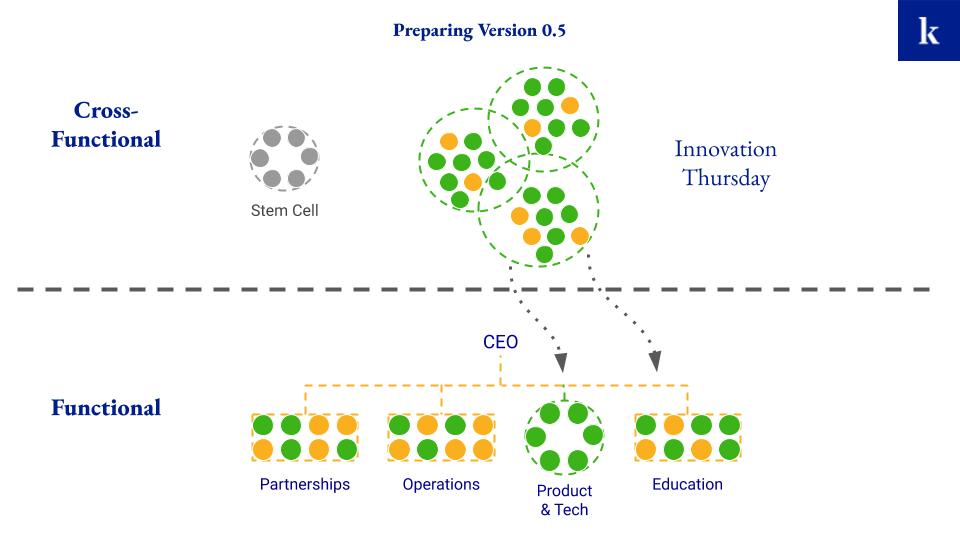
People get more used to cross-functional collaboration, to testing assumptions, to facing the unknown, to find out that something you believe is true may turn out to be wrong and something you think wouldn’t work actually does. More and more people develop the competences needed to innovate by using agile and lean principles and the quality of relationships improve. Some of the elements the stem cell and the clusters had dreamed up resurface again. We start linking our activities more and more to our new AARRR-based KPI’s and get out the experiment backlog again.
Now we are in the midst of taking it to the next level. Our management decided to merge the Product & Tech teams with the Education teams to form five cross-functional and self-organizing teams with people spending 100% of their time on it. They present the idea to each of the functional teams to get everyone’s feedback. And this time there’s less pushback, because people have developed the competences needed for this way of collaborating and the quality of the relationships, the cross-functional understanding and trust, has improved. We can now build on more fruitful ground. The plan is to use Large Scale Scrum (LeSS) as a foundation, which is a battle-tested framework for having multiple agile teams working on the same product. We will also bring back some of the growth hacking elements to prioritize our roadmap based on the potential impact an idea has.
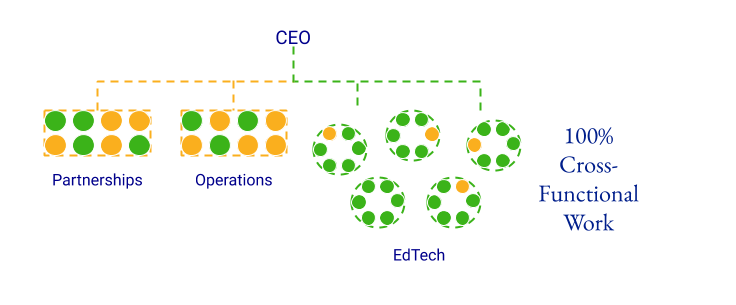
We had started our organizational transformation in April 2018 with elements from Laloux’s amber organizations (marked by hierarchy, formal roles and processes) being predominant; 14 months later in July 2019 the majority of our organization shows characteristics of orange (management by objective, innovation, a. o.) and green organizations (user-centeredness through agile and lean principles). And of course we’ll continue to evolve. People within the Partnerships and Operations teams are thinking about how they can make the shift. They have a harder time adapting to agile and lean principles, because Partnerships teams interface and collaborate with a lot of external organizations (and the models in which they operate) and Operations teams tend to be more hierarchical and process-focused. But we developed a framework that could show the way by grouping the type of work we’re doing in three buckets:
- Deliver on existing plans
- Innovate to create new plans
- Enable others to deliver or innovate
The idea is that each team reflects every 2 weeks on the type of work they were doing and to discuss if anything should change. And I’m sure that this will lead to yet another new version of our innovation ecosystem. In the end the only constant is change.
Closing Thoughts
- “You can’t connect the dots looking forward; you can only connect them looking backwards.” – Steve Jobs
Maybe when you read this it might seem like a linear and structured process, but I can assure you that it wasn't. There were a lot of ups and downs. Things that worked and things that didn’t. All the artefacts we produced, the materializations of our thinking and doing, were important stepping stones for where we are now - we may never tread on some of them again, but we wouldn’t be where we are without them. I feel incredibly lucky to be able to work with such a talented and kind spirited group of people. Together we have improved the quality of the soil, the quality of the social field, and planted the seeds for an innovation ecosystem that will keep on increasing our impact!
About
Björn Lefers works at the intersection of sustainability and education; education to better prepare people for a rapidly changing world and sustainability to make sure that world still exists when they’re finished. You can find him on LinkedIn.




